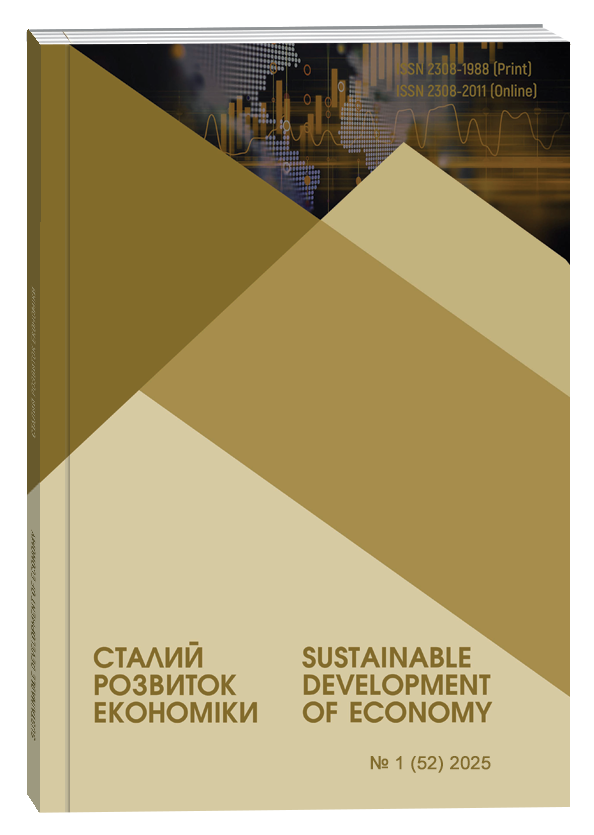BALANCE SHEET INFORMATION CONTENT: ANALYSIS OF STRUCTURE AND FUNCTIONS
Abstract
The balance sheet is the main instrument of financial reporting of an enterprise, which allows summarizing information about its financial position as of a particular date. The article examines the legal basis for balance sheet preparation, which is regulated by the Law of Ukraine “On Accounting and Financial Reporting in Ukraine” and the National Accounting Regulations (Standards) (NAR). Particular attention is paid to the analysis of the balance sheet structure, its main functions and characteristics, as well as its role in meeting the information needs of both internal and external users, such as investors, creditors and regulatory authorities. The study covers the historical development of the balance sheet concept, starting from the classical control over the accuracy of records to the modern understanding of it as a tool for analytical evaluation of assets, liabilities and capital of an enterprise. The balance sheet is considered as an important tool for managing the financial stability of an enterprise, allowing to identify trends in the structure of assets and liabilities, as well as providing a basis for developing development strategies, planning activities and assessing competitive advantages. Particular attention is paid to the analysis of the structure of the balance sheet of enterprises in Ukraine for 2021-2024, in particular among agricultural enterprises. The main trends in changes in balance sheet items are described, which reflect improved liquidity and financial stability, but there are also challenges, such as the growth of current liabilities. This study emphasizes the importance of financial statements for economic decision-making and emphasizes the importance of the correct balance sheet format to increase the information content and reliability of financial data. To improve the methodology of financial reporting, it is recommended that companies introduce automation of the process, which will reduce errors and reduce the time for preparing reports. It is also important to improve data control, expand analytical reporting capabilities, and ensure timely preparation of documents in accordance with regulatory requirements. Taking these measures into account will allow companies to improve the accuracy and transparency of financial reporting, which is critical for making informed management decisions.
References
Войтенко А., Свічкар Н. Особливості ведення обліку та складання бізнес-звітності в умовах воєнного стану. Управління змінами та інновації. 2023. № 5. С. 48-53. DOI: https://doi.org/10.32782/CMI/20232-5-8 (дата звернення: 02.01.2025).
Томчук В.В., Кашуба А.Г. Баланс як форма фінансової звітності під час воєнного стану. Економіка і організація управління. 2022. № 3(47). URL: https://jeou.donnu.edu.ua/article/view/13930 (дата звернення: 02.01.2025).
Грибовська Ю. Звітність за сегментами в контексті Міжнародних Стандартів фінансової звітності. Економіка та суспільство. 2023. № 47. DOI: https://doi.org/10.32782/2524-0072/2023-47-34 (дата звернення: 02.01.2025).
Кулик В.А., Левченко З.М., Єрмолаєва М.В. Таксономія фінансової звітності за міжнародними стандартами. Науковий вісник Херсонського державного університету. Серія Економічні науки. 2021. Вип. 41. С. 81-84. URL: https://www.ej.journal.kspu.edu/index.php/ej/article/view/711/696 (дата звернення: 02.01.2025).
Гуменюк А.Ф., Цимбалюк Г.С. Сутність та становлення балансу підприємства як основної форми фінансової звітності. Вісник Хмельницького національного університету. Економічні науки. 2020. № 2. С. 56-58.
Захарченко В.І., Лук’янчук О.М. Становлення та розвиток систематизованого аналізу фінансової звітності. Економіка: реалії часу. Науковий журнал. 2023. № 4 (68). С. 38-49. URL: https://economics.net.ua/files/archive/2023/Nо4/38.pdf (дата звернення: 02.01.2025).
Погорєлова Т.П., Сьоміна О.Р. Бухгалтерський баланс: його сутність, історія виникнення та технологія складання. Агросвіт. 2017. № 1–2. С. 44-48. URL: http://www.agrosvit.info/pdf/1-2_2017/10.pdf (дата звернення: 02.01.2025).
Лега О.В. Баланс підприємства: історія та сучасні реалії. Глобальні та національні проблеми економіки. 2016. Вип. 11. С. 863–868.
Добровольська О., Кравченко М., Даніленко О. Фінансова звітність як елемент системи управління підприємством. Економіка та суспільство. 2021. № 32. С. 32-34. DOI: https://doi.org/10.32782/2524-0072/2021-32-34 (дата звернення: 02.01.2025).
Колісник O., Шацков В. Аудит фінансової звітності: стратегія, план, процедури та методи. Економічний аналіз. 2024. Т. 34. № 1. С. 226–235.
Зозуляк М.М., Зубака Р.В. Сучасні підходи до аналізу та аудиту фінансової звітності підприємства. Освіта і наука. 2023. Вип. 2(35). С. 309-315 URL: http://dspace-s.msu.edu.ua:8080/handle/123456789/10299 (дата звернення: 02.01.2025).
Коваль Л.В., Томчук О.Ф., Немеш Г.С. Аналітичні властивості фінансової звітності. Вісник ХДУ. 2018. № 31. С. 193-197. URL: http://www.ej.journal.kspu.edu/index.php/ej/article/view/399 (дата звернення: 02.01.2025).
Гнатишин Л.Б. Організаційні аспекти та процедура формування фінансової звітності. Modern Economics. 2017. № 4. С. 43-51. URL: https://modecon.mnau.edu.ua/issue/4-2017/UKR/hnatyshyn.pdf (дата звернення: 02.01.2025).
Лагодієнко Н.В., Іванченкова Л.В., Скляр Л.Б., Іванченков В.С. Формат і зміст бухгалтерського балансу в сучасній обліково-економічній моделі Вісник Хмельницького національного університету. 2021. № 3. С. 21-28 URL: http://journals.khnu.km.ua/vestnik/wp-content/uploads/2022/03/2021-en-3-03.pdf (дата звернення: 02.01.2025).
Маліков В., Новіченко Л., Стойка Н. Бухгалтерська звітність: вимоги та складові. Економіка та суспільство. 2023. № 57. DOI: https://doi.org/10.32782/2524-0072/2023-57-86 (дата звернення: 02.01.2025).
Лега О.В., Яловега Л.В., Прийдак Т.Б. Помилки в бухгалтерському обліку: сутність, класифікаційні ознаки, виявлення та виправлення. Причорноморські економічні студії. 2020. Випуск 49. С.187-195.
Єрмолаєва М.В., Тютюнник С.В., Дугар Т.Є. Надзвичайні витрати: відображення в обліку та звітності. Інфраструктура ринку. 2022. № 67. С. 223-228. URL: http://www.market-infr.od.ua/journals/2022/67_2022/41.pdf (дата звернення: 02.01.2025).
Лега О.В. Відображення інформації про розрахунки з постачальниками та підрядниками у фінансовій звітності. Міжнародний збірник наукових праць. 2013. Випуск 1.
Пешков А., Лега О. Аналіз фінансової стійкості вітчизняних підприємств в умовах невизначеності. Цифрова економіка та економічна безпека. 2024. № 1 (10). С. 151-158. DOI: https://doi.org/10.32782/dees.10-27 (дата звернення: 02.01.2025).
Державна служба статистики України. URL: https://www.ukrstat.gov.ua/operativ/menu/menu_u/sze_20.htm (дата звернення 02.01.2025).
Voitenko, A., Svichkar, N. (2023). Osoblyvosti vedennia obliku ta skladannia biznes-zvitnosti v umovakh voiennoho stanu [Features of accounting and business reporting under martial law]. Upravlinnia zminamy ta innovatsii - Change Management and Innovation, no. (5), pp. 48-53. DOI: https://doi.org/10.32782/CMI/20232-5-8 (in Ukrainian)
Tomchuk V. V., Kashuba A. H. (2022) Balans yak forma finansovoi zvitnosti pid chas voiennoho stanu [Balance sheet as a form of financial reporting during martial law]. Ekonomika i orhanizatsiia upravlinnia - Economics and organization of management, vol. 3(47). Available at: https://jeou.donnu.edu.ua/article/view/13930 (in Ukrainian)
Hrybovska, Yu. (2023). Zvitnist za sehmentamy v konteksti Mizhnarodnykh Standartiv finansovoi zvitnosti [Segment reporting in the context of International Financial Reporting Standards]. Ekonomika ta suspilstvo - Economy and Society, no. (47). DOI: https://doi.org/10.32782/2524-0072/2023-47-34 (in Ukrainian)
Kulyk V. A., Levchenko Z. M., Yermolaieva M. V. (2021) Taksonomiia finansovoi zvitnosti za mizhnarodnymy standartamy [Taxonomy of financial reporting under international standards]. Naukovyi visnyk Khersonskoho derzhavnoho universytetu. Seriia Ekonomichni nauky - Scientific Bulletin of Kherson State University. Series of Economic Sciences, vol. 41, pp. 81-84. Available at: https://www.ej.journal.kspu.edu/index.php/ej/article/view/711/696 (in Ukrainian)
Humeniuk A. F., Tsymbaliuk H. S. (2020) Sutnist ta stanovlennia balansu pidpryiemstva yak osnovnoi formy finansovoi zvitnosti [The essence and formation of the enterprise balance sheet as the main form of financial reporting]. Visnyk Khmelnytskoho natsionalnoho universytetu. Ekonomichni nauky - Bulletin of Khmelnytsky National University. Economic Sciences, vol. 2, pp. 56-58. (in Ukrainian)
Zakharchenko V. I., Lukianchuk O. M. (2023) Stanovlennia ta rozvytok systematyzovanoho analizu finansovoi zvitnosti [Formation and development of systematized analysis of financial statements]. Ekonomika: realii chasu - Economics: the realities of time, vol. 4 (68), pp. 38-49. Available at: https://economics.net.ua/files/archive/2023/No4/38.pdf. (in Ukrainian)
Pohorielova T. P., Somina O. R. (2017) Bukhhalterskyi balans: yoho sutnist, istoriia vynyknennia ta tekhnolohiia skladannia [Accounting balance sheet: its essence, history of origin and technology of preparation]. Ahrosvit - Agrosvit, vol. 1, pp. 44-48. Available at: http://www.agrosvit.info/pdf/1-2_2017/10.pdf (in Ukrainian)
Leha O.V. (2016) Balans pidpryiemstva: istoriia ta suchasni realii [Enterprise balance sheet: history and modern realities]. Hlobalni ta natsionalni problemy ekonomiky - Global and national problems of the economy, vol. 11, pp. 863–868. (in Ukrainian)
Dobrovolska, O., Kravchenko, M., Danilenko, O. (2021) Finansova zvitnist yak element systemy upravlinnia pidpryiemstvom [Financial reporting as an element of the enterprise management system]. Ekonomika ta suspilstvo - Economy and Society, vol. 32, pp. 32-34. DOI: https://doi.org/10.32782/2524-0072/2021-32-34 (in Ukrainian)
Kolisnyk O., Shatskov V. (2024) Audyt finansovoi zvitnosti: stratehiia, plan, protsedury ta metody [Audit of financial statements: strategy, plan, procedures and methods]. Ekonomichnyi analiz - Economic analysis, vol. 1, pp. 226–235. (in Ukrainian)
Zozuliak, M. M., Zubaka, R. V. (2023) Suchasni pidkhody do analizu ta audytu finansovoi zvitnosti pidpryiemstva [Modern approaches to the analysis and audit of financial statements of the enterprise]. Osvita i nauka - Education and science, vol. 2(35), pp. 309-315 Available at: http://dspace-s.msu.edu.ua:8080/handle/123456789/10299 (in Ukrainian)
Koval L.V., Tomchuk O.F., Nemesh H.S. (2018) Analitychni vlastyvosti finansovoi zvitnosti [Analytical properties of financial statements]. Visnyk KhDU - Herald of KSU. vol. 31, pp. 193-197. Available at: http://www.ej.journal.kspu.edu/index.php/ej/article/view/399 (in Ukrainian)
Hnatyshyn L. B. (2017) Orhanizatsiini aspekty ta protsedura formuvannia finansovoi zvitnosti [Organizational aspects and procedure for the formation of financial statements]. Modern Economics. vol. 4, pp. 43-51. Available at: https://modecon.mnau.edu.ua/issue/4-2017/UKR/hnatyshyn.pdf (in Ukrainian)
Lahodiienko N. V., Ivanchenkova L. V., Skliar L. B., Ivanchenkov V. S. (2021) Format i zmist bukhhalterskoho balansu v suchasnii oblikovo-ekonomichnii modeli [Format and content of the balance sheet in the modern accounting and economic model]. Visnyk Khmelnytskoho natsionalnoho universytetu - Bulletin of Khmelnytsky National University. vol. 3, pp. 21-28 Available at: http://journals.khnu.km.ua/vestnik/wp-content/uploads/2022/03/2021-en-3-03.pdf (in Ukrainian)
Malikov, V., Novichenko, L., Stoika, N. (2023). Bukhhalterska zvitnist: vymohy ta skladovi [Accounting reporting: requirements and components]. Ekonomika ta suspilstvo - Economy and society, no. (57). DOI: https://doi.org/10.32782/2524-0072/2023-57-86 (in Ukrainian)
Leha O. V., Yaloveha L. V., Pryidak T. B. (2020) Pomylky v bukhhalterskomu obliku: sutnist, klasyfikatsiini oznaky, vyiavlennia ta vypravlennia [Errors in accounting: essence, classification features, detection and correction]. Prychornomorski ekonomichni studii - Black Sea Economic Studies, vol. 49, pp. 187-195. (in Ukrainian)
Yermolaieva M. V., Tiutiunnyk S. V., Duhar T. Ye. (2022) Nadzvychaini vytraty: vidobrazhennia v obliku ta zvitnosti [Extraordinary expenses: reflection in accounting and reporting]. Infrastruktura rynku - Market infrastructure. vol. 67, pp. 223-228. Available at: http://www.market-infr.od.ua/journals/2022/67_2022/41.pdf (in Ukrainian)
Leha O.V. (2013) Vidobrazhennia informatsii pro rozrakhunky z postachalnykamy ta pidriadnykamy u finansovii zvitnosti [Reflection of information on settlements with suppliers and contractors in financial statements]. Mizhnarodnyi zbirnyk naukovykh prats - International collection of scientific papers, vol. 1. (in Ukrainian)
Peshkov, A., Leha, O. (2024). Analiz finansovoi stiikosti vitchyznianykh pidpryiemstv v umovakh nevyznachenosti [Analysis of the financial stability of domestic enterprises under conditions of uncertainty]. Tsyfrova ekonomika ta ekonomichna bezpeka - Digital economy and economic security, no. (1 (10), pp. 151-158. Available at: https://doi.org/10.32782/dees.10-27 (in Ukrainian)
Derzhavna sluzhba statystyky Ukrainy [State Statistics Service of Ukraine]. Available at: https://www.ukrstat.gov.ua/operativ/menu/menu_u/sze_20.htm (in Ukrainian)


